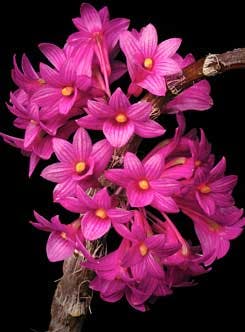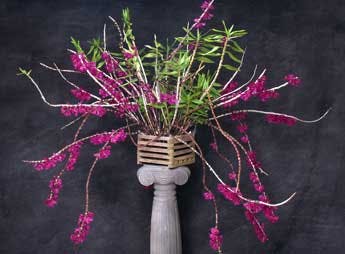
The beautiful flowers of Dendrobium goldschmidtianum range in color from deep fuchsia to soft pink.
Dendrobium goldschmidtianum is one of our favorite orchids because of ease of growth and the showy display it puts on every Christmas. Even better than that, it follows that December blooming with a slightly lesser one 6-8 weeks after that and can push flushes of flowers throughout the year. Flower color ranges from intense purple-violet to soft pink. Long known as Dendrobium miyakei Schltr., the species is a member of the Pedilonum section of Dendrobium which to this grower's mind, does not have any bad orchids. The Pedilonum section has many showy orchids in a rainbow of colors and wide range of temperature tolerences to suit any grower's conditions. See the Orchids AtoZ section of this website for other species. Pedilonum comes from the Greek word pedilon which means slipper or shoe. This refers to the long mentum, or chinlike projection, formed by the joining of the sepals. There was much confusion in the section, with species being known by several different names, until Dr. Elizabeth Dauncey's 1994 thesis which corrected much of the synonmy. There are about 47 species in the section with the center of distribution being Papua New Guinea.
Dendrobium goldschmidtianum is a lowland species found in a restricted range of southern Taiwan and Batan island in the northern Philippines. It reportedly has been seen growing as an epiphyte on branches of Ficus retusa. This fig tree is a popular subject for Bonsai.
Plants of Dendrobium goldschmidtianum can be tall, up to 3 feet (.9m) or more, but they are space efficient horizontally. In other words, they do not take up much bench space, or more correctly, can be made to not take up much space. The Grand Champion at the 2007 Tokyo Dome show was a meticulously staked Den. goldscmidtianum that was considerably taller than the above measurement. These are orchids that typically bloom off of deciduous second-year canes, although some related species will continue flowering from old canes until they shrivel away to nothing. One of the most frequent questions I am asked is "can I cut the old canes off?". You don't need to if they are still firm. Leave them be, they just may bloom again!
Although growth occurs all year, the main flush begins in the spring and continues through summer. New canes emerge upright and stay erect until the weight of the leaves begins to give them a lax attitude. Once the leaves drop in the fall the canes will display a nice arching effect. We like to keep plants tied upright until we see bud development. This keeps them confined to a space efficient footprint. When we untie them for flowering the plants become a nicely arched full plant.

Given the right culture, plants grow quickly to specimen size and put on quite a show.
The following culture suggestions are based on our experience growing plants in South Florida. Our warm and breezy outdoor growing conditions are perfect for optimum growth. These recommendations also apply to northern temperate growers but you will likely see less vigorous results. Den. goldschmidtianum can be grown like vandas or catasetums. Give them plenty of light, water and nutrients when in active growth, which is spring through fall. If you are growing orchids in a cool, low-light northern greenhouse or windowsill you will want to moderate this regimen a bit because growth will be lessened by your conditions. If you can summer plants outdoors then by all means, do so. Small plants, 5-6 live canes under 12" tall, can be grown in plastic pots of your favorite potting mix. Keep plants in a bright spot and keep them evenly moist until autumn. Fertilze once a week while in growth. When temperatures begin to cool in the autumn, for us here in Florida that is around Thanksgiving but will probably be earlier in the northern tier of states, start to hold back water. Do not give plants any water unless canes begin to look excessively shriveled. When you feel them they should be firm. Give plants water only if the canes begin to really shrivel. DO NOT give plants any fertilizer at this time. In mid winter buds should appear. After they are halfway developed you may resume watering but just enough to keep the media barely damp. In other words, plants are not in growth in the winter so their water needs are less. Just give them enough water to mitigate the stress of flower production. Resume normal watering in the spring when tepmeratures begin to warm and days lengthen.
If you have the right conditions and end up with a large 20-cane plant after a few years you may want to discard the conventional wisdom regarding underpotting dendrobiums. We grow this and related species in 6-10 inch baskets of sphagnum moss and find that the root system can fill a basket and "eat" the moss in a year or so. A vigorous plant of Dendrobium goldschmidtianum can produce and extensive system of fine roots in a very short time if given the right growing conditions.
If you long for this species but feel your conditions may be too cool, too shady or too small, consider other species in the Pedilonum and closely related Calyptrochilum and Calcarifera sections of Dendrobium. There are many excellent cooler growing and miniature orchids such as Dendrobium alaticaulinum, Den. dichaeoides, Den. fulgidum, Den. lawesii, and the beautiful Den. victoria-reginae. Be sure to see the April issue of Orchids magazine for a survey of the Pedilonum section of Dendrobium.
References
Cootes, Jim. 2001. The Orchids of the Philippines. Timber Press.
Lavarack, B, Harris W., Stocker, G. 2000. Dendrobium and its Relatives. Timber Press.
Greg Allikas, February 2009









